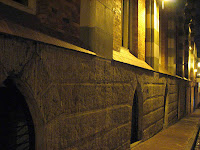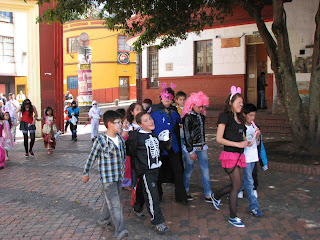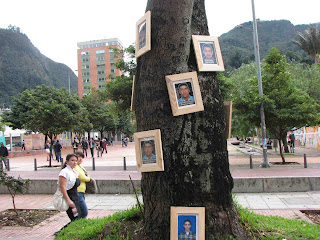 |
| Calle del Fantasma, or Ghost Street, in La Candelaria. |
It was not long after I moved to Bogotá, into an older, crumbling house in the upper La Candelaria neighborhood. I was lying in bed one night when I heard a strange scratching noise on the outside of my door. I grabbed a piece of wood and went to investigate. Naturally, I found nothing there. Only later did I learn that the previous resident had died in that room - and that the neighboring street is called 'La Calle de los Fantasmas' - 'The Street of the Ghosts.'
Thanks to its age and the many bloody dramas it's experienced, it seems likely that there are ghosts anywhere, they're here in La Candelaria.
 |
| Estela Monsalve, who told ghost stories. |
I also knew a tremendous old woman,
Estela Monsalve, who did ghost tours thru the neighborhood. Short, wrinkled and stooped, but full of life, she had the spirit of a teenager. Once we went to a chicha bar in the Callejon del Embudo. 'Do you want to see my identification?' she asked the bartender. Apparently, Estela was a regular. Sadly, Stela died a few years ago, but after a full life. She was one of Colombia's first women lawyers. And, fortunately, her stories live on.
 |
The Calle del Sol apartment buiding,
once the secret police HQ. |
 |
The side of the Calle del Sol,
once the location of the dungeon. |
The Calle del Sol, on Carrera 3 and Calle 11, is today an expensive apartment building, but was once a monastery and, during the 1950s, '60s and '70s, the secret police headquarters. Undoubtedly, lots of terrible things happened here, particularly during the years of dictatorship in the mid-1950s. According to
this paper, residents there still report sensing ghosts in the building. And the fancy restaurant on the buildings Calle 12 side, which occupies the space which was the dungeon, is called 'La Bruja', or 'The Witch.'
 |
| Carrera 2. Russi's home is the yellow one on the right. |
On Carrera 2 between Calles 10 and 11, in the 1800s there lived Jose Raimundo Russi, an attorney who represented thieves, prostitutes and other social outcasts. Finally, Russi himself was accused in involvement in crime, tried and executed. They say that his spirit is still seen in the neighborhood.
Around the corner, on Carrera 3 and Calle 10, some people say that clothing left dirty would be found the next day mysteriously washed and hung on the line. The phenomenon continued until one day while repairing a house workers found a woman's body buried in the wall. The woman was properly buried and to everybody's disappointment the ghostly washings ceased.
On Calle 13 and Carrera 5, it's said, there lived a woman who was pregnant, but single - a scandal in the 18th century. She gave birth and killed the child, whose spirit supposedly still haunts the neighborhood, grabbing unsuspecting women by their legs.
Supposedly, a ghost haunts the Gilberto Alzate foundation building on Calle 10 and Carrera 3, once the residence of the Virrey, the Spanish king's representative for the region. Today, it's said, employees sometimes hear a ghost wandering its halls.
 |
| A ghostly figure on the wall of the Gilberto Alzate Foundation. |
 |
| Callejon de las Brujas, or Witches Alley, off of La Plaza del Chorro. |
 |
| Martyrs Plaza near La Candelaria. Many patriots were executed here and it's a likely haunt for ghosts today. |
By Mike Ceaser, of
Bogotá Bike Tours































































